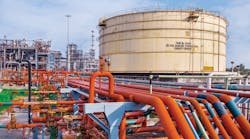China Petroleum & Chemical Corp. (Sinopec) has commissioned its Sinopec Zhongke Refinery Port—now China’s largest petrochemical port—which was built as part of the operator’s integrated refining and petrochemical complex nearing completion on Donghai Island, Zhanjiang City, Guangdong Province (OGJ Online, Nov. 10, 2017).
The port entered operation on May 9 with the docking of the New Renown—a very large crude carrier (VLCC) delivering crude supplies from the Middle East—at the port’s crude oil terminal, Sinopec said.
Situated on the east coast of Zhanjiang about 1,100 m from Zhongke (Guangdong) Refining & Petrochemical Co. Ltd.’s (ZGRPCL) yet-to-be-commissioned 10 million-tonnes/year integrated complex, the new petrochemical port features eight terminals, including a 300,000-tonnes crude oil berth, 100,000-tonnes oil berth, and supporting facilities that, combined, provide a total capacity of 34 million tpy.
With its loading and unloading capacity of 5.61 million tpy, the 100,000-tonnes berth is now China’s largest domestic refined oil terminal, providing convenient access to refined oil and chemical products for Sinopec's core domestic market, while also offering direct opportunities for global exports to enhance the company’s industrial competitiveness, Sinopec said.
The port forms part of ZGRPCL’s integrated refining and petrochemical complex—a key component of Guangdong Province’s 13th 5-Year Plan—the first 40 billion-yuan phase of which reached mechanical completion on Dec. 28, 2019, according to Sinopec’s 2019 annual report to investors.
Initially planned as a joint-venture project between Sinopec and Kuwait Petroleum Corp., ZGRPCL’s complex—alongside the 10 million-tpy crude distillation unit designed to process Kuwaiti crude—will include an 800,000-tpy ethylene steam cracker, a 400,000-tpy pyrolysis gasoline hydrogenation unit, a 550,000-tpy polypropylene unit, a 350,000-tpy high-density polyethylene unit, a 250,000-tpy ethylene oxide unit, a 400,000-tpy ethylene glycol unit, and a 100,000-tpy ethylene vinyl acetate, according to Jan. 18, 2018, and Mar. 19, 2018, announcements from Sinopec Engineering (Group) Co. Ltd., which was contracted to deliver engineering, procurement, and construction services for the project’s major petrochemical units.
Various Chinese local media outlets also have reported the complex will include the following major processing capacities:
- Residual oil hydrotreating, 4.4 million tpy.
- Fluid catalytic cracking, 4.2 million tpy.
- Gas oil hydrotreating, 2 million tpy.
- Hydrocracking, 2 million tpy.
- Light hydrocarbon recovery, 2 million tpy.
- Continuous catalytic reforming, 1.8 million tpy.
As of May, Sinopec said there are more than 18,000 builders currently working on-site to complete the ZGRPCL project, for which an unidentified 28 of the complex’s 30 major production installations already have been delivered.
Sinopec said it expects to fully complete construction activities and enter ZGRPCL’s complex into operation by the end of July.


